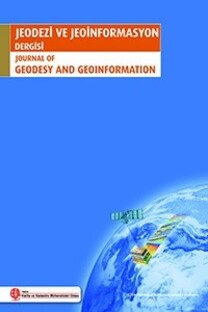GPS sinyal gürültü oranı verileri ile kar kalınlığının belirlenmesi
GPS teknolojisi, tektonik aktivitelerin izlenmesi, deformasyon analizi, hassas nokta konumlama gibi pek çok jeodezik çalışma için hassas veri sağlamaktadır. Bu çalışmalarda kullanılacak doğruluğu yüksek verinin analizi için uydulardan gönderilen sinyallerin çok yolluluk etkisinden arındırılması gerekmektedir. Genel bir tanım olarak, bir uydudan yayılan sinyalin GPS/GNSS alıcısına birden fazla yoldan ulaşmasına çok yolluluk denir. Bu çok yolluluk genellikle alıcının yakın çevresinde bulunan yansıma yüzeylerinden kaynaklanmaktadır. Böylece, uydu sinyalleri, doğrudan ve dolaylı yolları izleyerek alıcıya ulaşırlar. Hassas nokta konum belirleme vb. jeodezik çalışmalarda, çok yolluluk istenmeyen bir etkidir ve ölçülerden arındırılması gerekir. Ancak, son yıllarda yapılan çalışmalar, GPS enterferometrik yansıma yöntemi ile GPS alıcısı etrafındaki farklı yüzeylerden yansıyarak gelen bu istenmeyen GPS sinyallerinin yansıma yüzeyine ait kar kalınlığı, toprak nem oranı, deniz seviyesi değişimi gibi bilgilerin elde edilmesinde kullanılabileceğini göstermiştir. Bu çalışmada, GPS çok yolluluk verilerinden yararlanarak, kar kalınlığının belirlenmesi amaçlanmıştır. Bu amaçla, Alaska’da bulunan AB33 istasyonuna ait 1 Ocak 2015-31 Aralık 2015 tarihlerini kapsayan 1 yıllık GPS verisi kullanılmış ve mevsimsel değişimleri de içeren 1 yıllık kar kalınlık değişimleri incelenmiştir.
Anahtar Kelimeler:
Sinyal-gürültü oranı (SNR), GPS enterferometrik yansıma, Kar kalınlığı, Sinyal çok yolluluğu
Determination of snow depth by GPS signal to noise ratio
GPS technology provides precise data for many geodetic studies such as monitoring the tectonic activities, deformation analysis, high-precision point positioning. For high-accuracy analysis of the data to be used in these studies, the multipath effect should be eliminated from the GPS signals. As a general definition, a satellite emitted signal arrives at the receiver by more than one path is so called multipath. This multipath is usually caused by reflection surfaces around the receiver. Thus, satellite signals reach the receiver by following direct and indirect paths. In geodetic studies, where precise positioning is required, multipath is an undesirable effect and should be removed from measurements. However, recent studies have shown that these unwanted GPS signals, which are reflected from different surfaces around GPS receiver, can be used to retrieval information of the reflecting surface such as snow depth, soil moisture content, sea level change with GPS interferometric reflectometry technique. In this study, it is aimed to determine snow depth from GPS multipath data. For this purpose, 1-year GPS data of the AB33 located in Alaska station for the period of 1 January 2015-31 December 2015 was used and 1-year snow depth variations including seasonal changes were investigated.
___
- Bilich, A., Larson, K. M., & Axelrad, P. (2008). Modeling GPS phase multipath with SNR: Case study from the Salar de Uyuni, Boliva. Journal of Geophysical Research: Solid Earth, 113(B4).
- Chen, Q., Won, D., & Akos, D. M. (2014). Snow depth sensing using the GPS L2C signal with a dipole antenna. EURASIP Journal on Advances in Signal Processing, 2014(1), 106.
- Hofmann-Wellenhof, B., Lichtenegger, H., & Wasle, E. (2007). GNSS–global navigation satellite systems: GPS, GLONASS, Galileo, and more. Springer Science & Business Media.
- Larson, K. M., Small, E. E., Gutmann, E., Bilich, A., Axelrad, P., & Braun, J. (2008). Using GPS multipath to measure soil moisture fluctuations: initial results. GPS Solutions, 12(3), 173-177.
- Larson, K. M., Gutmann, E. D., Zavorotny, V. U., Braun, J. J., Williams, M. W., & Nievinski, F. G. (2009). Can we measure snow depth with GPS receivers?. Geophysical Research Letters, 36(17).
- Larson, K. M., & Nievinski, F. G. (2013). GPS snow sensing: results from the EarthScope Plate Boundary Observatory. GPS Solutions, 17(1), 41-52.
- Larson, K. M., & Small, E. E. (2016). Estimation of snow depth using L1 GPS signal-to-noise ratio data. IEEE Journal of Selected Topics in Applied Earth Observations and Remote Sensing, 9(10), 4802-4808.
- Martin-Neira, M. (1993). A passive reflectometry and interferometry system (PARIS): Application to ocean altimetry. ESA Journal, 17(4), 331-355.
- Nievinski, F. G., & Larson, K. M. (2014). Inverse modeling of GPS multipath for snow depth estimation—Part I: Formulation and simulations. IEEE Transactions on Geoscience and Remote Sensing, 52(10), 6555-6563.
- Qian, X., & Jin, S. (2016). Estimation of snow depth from GLONASS SNR and phase-based multipath reflectometry. IEEE Journal of Selected Topics in Applied Earth Observations and Remote Sensing, 9(10), 4817-4823.
- Tabibi, S., Geremia-Nievinski, F., & van Dam, T. (2017). Statistical comparison and combination of GPS, GLONASS, and multi-GNSS multipath reflectometry applied to snow depth retrieval. IEEE Transactions on Geoscience and Remote Sensing, 55(7), 3773-3785.
- URL-1: T.C. Tarım ve Orman Bakanlığı, Meteoroloji Genel Müdürlüğü, https://www.mgm.gov.tr/iklim/iklim-degisikligi.aspx.
- URL-2: https://www.unavco.org/instrumentation/networks/status/pbo/photos/ab33.
- ISSN: 2147-1339
- Yayın Aralığı: Yılda 2 Sayı
- Başlangıç: 2012
- Yayıncı: TMMOB Harita ve Kadastro Mühendisleri Odası
